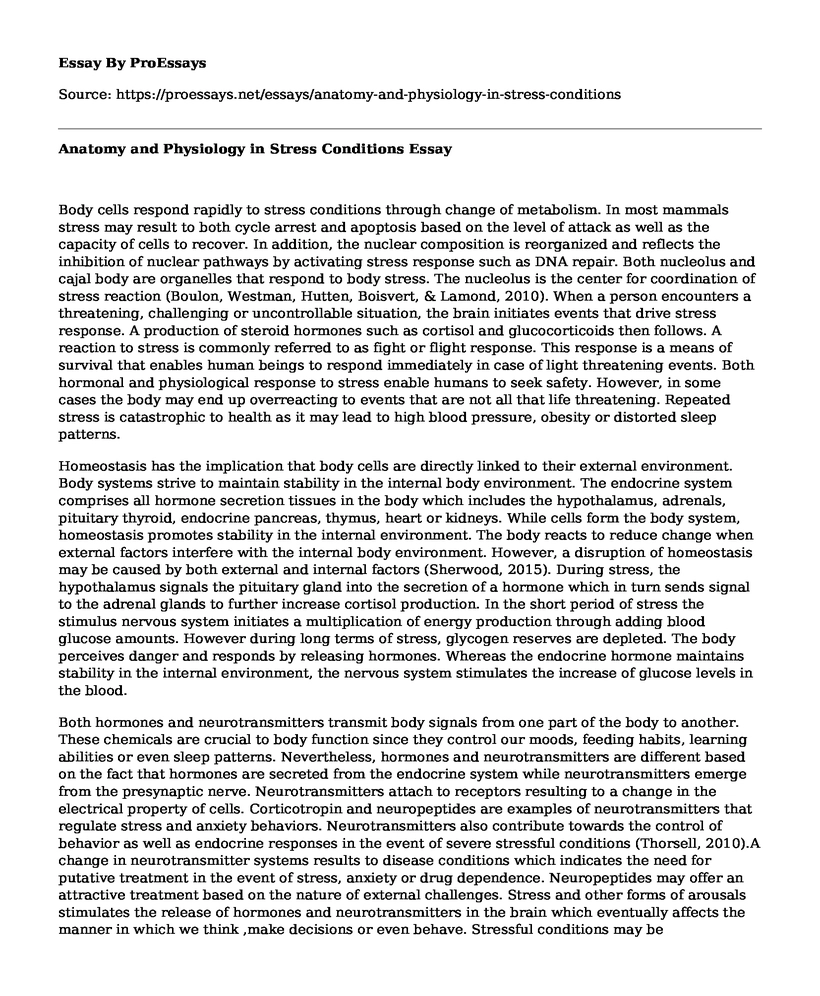Body cells respond rapidly to stress conditions through change of metabolism. In most mammals stress may result to both cycle arrest and apoptosis based on the level of attack as well as the capacity of cells to recover. In addition, the nuclear composition is reorganized and reflects the inhibition of nuclear pathways by activating stress response such as DNA repair. Both nucleolus and cajal body are organelles that respond to body stress. The nucleolus is the center for coordination of stress reaction (Boulon, Westman, Hutten, Boisvert, & Lamond, 2010). When a person encounters a threatening, challenging or uncontrollable situation, the brain initiates events that drive stress response. A production of steroid hormones such as cortisol and glucocorticoids then follows. A reaction to stress is commonly referred to as fight or flight response. This response is a means of survival that enables human beings to respond immediately in case of light threatening events. Both hormonal and physiological response to stress enable humans to seek safety. However, in some cases the body may end up overreacting to events that are not all that life threatening. Repeated stress is catastrophic to health as it may lead to high blood pressure, obesity or distorted sleep patterns.
Homeostasis has the implication that body cells are directly linked to their external environment. Body systems strive to maintain stability in the internal body environment. The endocrine system comprises all hormone secretion tissues in the body which includes the hypothalamus, adrenals, pituitary thyroid, endocrine pancreas, thymus, heart or kidneys. While cells form the body system, homeostasis promotes stability in the internal environment. The body reacts to reduce change when external factors interfere with the internal body environment. However, a disruption of homeostasis may be caused by both external and internal factors (Sherwood, 2015). During stress, the hypothalamus signals the pituitary gland into the secretion of a hormone which in turn sends signal to the adrenal glands to further increase cortisol production. In the short period of stress the stimulus nervous system initiates a multiplication of energy production through adding blood glucose amounts. However during long terms of stress, glycogen reserves are depleted. The body perceives danger and responds by releasing hormones. Whereas the endocrine hormone maintains stability in the internal environment, the nervous system stimulates the increase of glucose levels in the blood.
Both hormones and neurotransmitters transmit body signals from one part of the body to another. These chemicals are crucial to body function since they control our moods, feeding habits, learning abilities or even sleep patterns. Nevertheless, hormones and neurotransmitters are different based on the fact that hormones are secreted from the endocrine system while neurotransmitters emerge from the presynaptic nerve. Neurotransmitters attach to receptors resulting to a change in the electrical property of cells. Corticotropin and neuropeptides are examples of neurotransmitters that regulate stress and anxiety behaviors. Neurotransmitters also contribute towards the control of behavior as well as endocrine responses in the event of severe stressful conditions (Thorsell, 2010).A change in neurotransmitter systems results to disease conditions which indicates the need for putative treatment in the event of stress, anxiety or drug dependence. Neuropeptides may offer an attractive treatment based on the nature of external challenges. Stress and other forms of arousals stimulates the release of hormones and neurotransmitters in the brain which eventually affects the manner in which we think ,make decisions or even behave. Stressful conditions may be characterized by an impaired working memory which depends on the neurochemical balance of the prefrontal cortex. Mental illnesses such as schizophrenia, hyperactivity disorder or major depressive disorders are attributed to the prefrontal cortex dysfunction (Shansky & Lipps, 2013).
References
Boulon, S., Westman, B. J., Hutten, S., Boisvert, F. M., & Lamond, A. I. (2010). The nucleolus under stress. Molecular cell, 40(2), 216-227.
Shansky, R. M., & Lipps, J. (2013). Stress-induced cognitive dysfunction: hormone-neurotransmitter interactions in the prefrontal cortex. Frontiers in human neuroscience, 7, 123.
Sherwood, L. (2015). Human physiology: from cells to systems. Cengage learning.
Thorsell, A. (2010). Brain neuropeptide Y and corticotropin-releasing hormone in mediating stress and anxiety. Experimental Biology and Medicine, 235(10), 1163-1167.
Cite this page
Anatomy and Physiology in Stress Conditions. (2022, Mar 10). Retrieved from https://proessays.net/essays/anatomy-and-physiology-in-stress-conditions
If you are the original author of this essay and no longer wish to have it published on the ProEssays website, please click below to request its removal:
- Essay Sample on Individual Creative Thinking Profile
- The Influence of Social Media on Teen's Self Esteem Paper Example
- New Safety Program Paper Example
- Maternal Depression: Low Self-Esteem, Fatigue & More - Essay Sample
- Essay Sample on Humans-Environment Interactions: A Constant Struggle for Survival
- Article Analysis Essay on The Story of Yingying
- Fact Paper Example: Important Life Event







